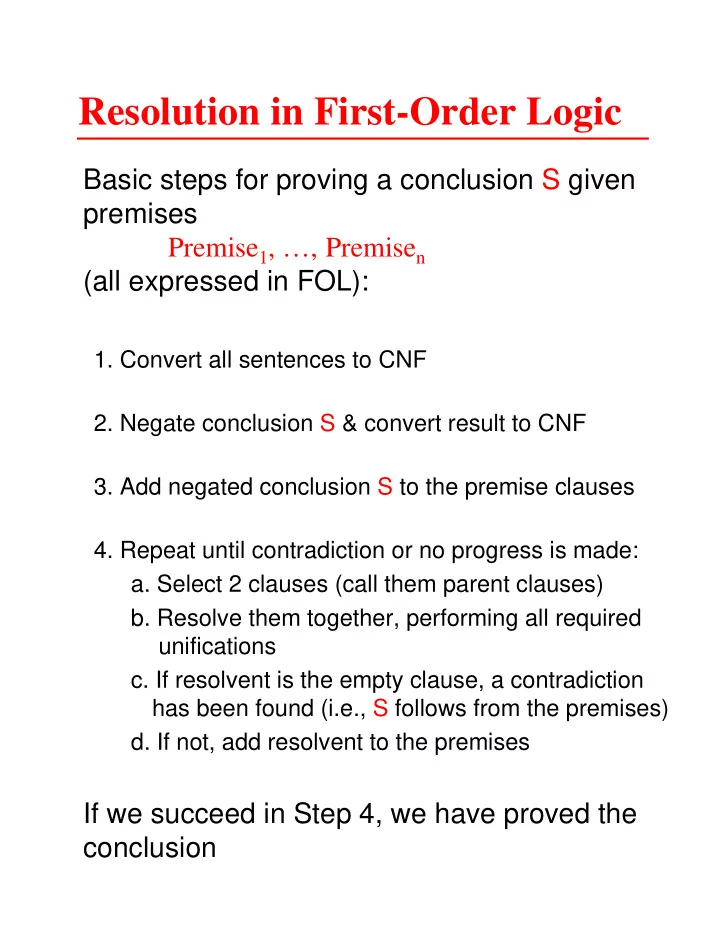

Resolution in First-Order Logic Basic steps for proving a conclusion S given premises Premise 1 , …, Premise n (all expressed in FOL): 1. Convert all sentences to CNF 2. Negate conclusion S & convert result to CNF 3. Add negated conclusion S to the premise clauses 4. Repeat until contradiction or no progress is made: a. Select 2 clauses (call them parent clauses) b. Resolve them together, performing all required unifications c. If resolvent is the empty clause, a contradiction has been found (i.e., S follows from the premises) d. If not, add resolvent to the premises If we succeed in Step 4, we have proved the conclusion
Resolution Examples Example 1: • If something is intelligent, it has common sense • Deep Blue does not have common sense • Prove that Deep Blue is not intelligent 1. ∀ x.I(x) ⇒ H(x) C1: ¬ I(x) ∨ H(x) 2. ¬ H(D) C2: ¬ H(D) Conclusion: ¬ I(D) CNF Denial: C3: I(D) A resolution proof of ¬ I(D): ¬ I(x) ∨ H(x) ¬ H(D) {x/D} ¬ I(D) I(D) 2nd literal, Proof also written as: 1st clause C4: ¬ I(D) r[C1b, C2] C5: r[C3, C4]
Resolution Examples (cont.) Example 2: Premises: Prove: Older(Lulu, Fifi) Mother(Lulu, Fifi) Denial: Alive(Lulu) ¬ Older(Lulu, Fifi) ∀ x ∀ y.Mother(x,y) ⇒ Parent(x,y) ∀ x ∀ y.(Parent(x,y) ∧ Alive(x)) ⇒ Older(x,y) Mother(Lulu,Fifi) ¬ Mother(x,y) ∨ Parent(x,y) {x/Lulu,y/Fifi} Parent(Lulu,Fifi) ¬ Parent(x,y) ∨ ¬ Alive(x) ∨ Older(x,y) {x/Lulu,y/Fifi} ¬ Alive(Lulu) ∨ Older(Lulu, Fifi) Alive(Lulu) ¬ Older(Lulu, Fifi) Older(Lulu, Fifi)
Resolution Examples (cont.) Example 3: • Suppose the desired conclusion had been “Something is older than Fifi” ∃ x.Older(x, Fifi) • Denial: ¬ ∃ x.Older(x, Fifi) also written as: ∀ x. ¬ Older(x, Fifi) in clause form: ¬ Older(x, Fifi) • Last proof step would have been C8: Older(Lulu,Fifi) C5’: ¬ Older(x, Fifi) {x/Lulu} Don’t make mistake of first forming clause from conclusion & then denying it: • Conclusion: Cannot unify ∃ x.Older(x, Fifi) Lulu,C!! clause form: Older(C, Fifi) denial: ¬ Older(C, Fifi)
Question-Answering Example 1: “Who is Lulu older than?” • Prove that “there is an x such that Lulu is older than x” • In FOL form: ∃ x.Older(Lulu, x) • Denial: ¬∃ x.Older(Lulu, x) ∀ x. ¬ Older(Lulu, x) in clause form: ¬ Older(Lulu, x) • Successful proof gives {x/Fifi} [Verify!!] Example 2: “What is older than what?” • In FOL form: ∃ x ∃ y.Older(x, y) • Denial: ¬∃ x ∃ y.Older(x, y) in clause form: ¬ Older(x, y) • Successful proof gives {x/Lulu, y/Fifi} [Verify!!]
Recommend
More recommend